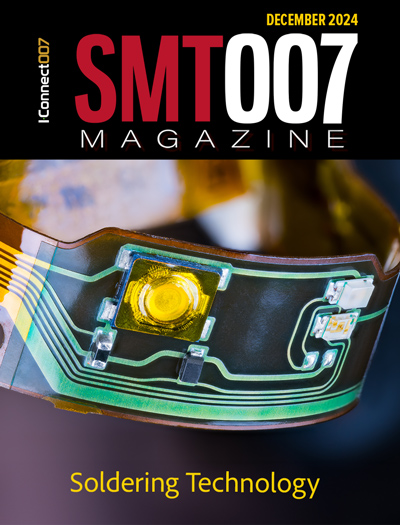-

- News
- Books
Featured Books
- smt007 Magazine
Latest Issues
Current Issue
The Path Ahead
What are you paying the most attention to as we enter 2025? Find out what we learned when we asked that question. Join us as we explore five main themes in the new year.

Soldering Technologies
Soldering is the heartbeat of assembly, and new developments are taking place to match the rest of the innovation in electronics. There are tried-and-true technologies for soldering. But new challenges in packaging, materials, and sustainability may be putting this key step in flux.

The Rise of Data
Analytics is a given in this industry, but the threshold is changing. If you think you're too small to invest in analytics, you may need to reconsider. So how do you do analytics better? What are the new tools, and how do you get started?
- Articles
- Columns
Search Console
- Links
- Media kit
||| MENU - smt007 Magazine
New Approach Brings Industry a Step Closer to Transparent Electronics
April 8, 2021 | FleetEstimated reading time: 3 minutes
A new study could pave the way to revolutionary, transparent electronics.
Such see-through devices could potentially be integrated in glass, in flexible displays and in smart contact lenses, bringing to life futuristic devices that seem like the product of science fiction.
For several decades, researchers have sought a new class of electronics based on semiconducting oxides, whose optical transparency could enable these fully-transparent electronics.
Oxide-based devices could also find use in power electronics and communication technology, reducing the carbon footprint of our utility networks.
A RMIT-led team has now introduced ultrathin beta-tellurite to the two-dimensional (2D) semiconducting material family, providing an answer to this decades-long search for a high mobility p-type oxide.
“This new, high-mobility p-type oxide fills a crucial gap in the materials spectrum to enable fast, transparent circuits,” says team leader Dr Torben Daeneke, who led the collaboration across three FLEET nodes.
Other key advantages of the long-sought-after oxide-based semiconductors are their stability in air, less-stringent purity requirements, low costs and easy deposition.
“In our advance, the missing link was finding the right, ‘positive’ approach,” says Torben.
Positivity Has Been Lacking
There are two types of semiconducting materials. ‘N-type’ materials have abundant negatively-charged electrons, while ‘p-type’ semiconductors possess plenty of positively-charged holes.
It’s the stacking together of complementary n-type and p-type materials that allows electronic devices such as diodes, rectifiers and logic circuits.
Modern life is critically reliant on these materials since they are the building blocks of every computer and smartphone.
A barrier to oxide devices has been that while many high-performance n-type oxides are known, there is a significant lack of high-quality p-type oxides.
Theory Prompts Action
However in 2018 a computational study revealed that beta-tellurite (?-TeO2) could be an attractive p-type oxide candidate, with tellurium’s peculiar place in the periodic table meaning it can behave as both a metal and a non-metal, providing its oxide with uniquely useful properties.
“This prediction encouraged our group at RMIT University to explore its properties and applications,” says Dr Torben Daeneke, who is a FLEET associate investigator.
Liquid Metal – Pathway to Explore 2D Materials
Dr Daeneke’s team demonstrated the isolation of beta-tellurite with a specifically developed synthesis technique that relies on liquid metal chemistry.
“A molten mixture of tellurium (Te) and selenium (Se) is prepared and allowed to roll over a surface,” explains co-first author Patjaree Aukarasereenont.
“Thanks to the oxygen in ambient air, the molten droplet naturally forms a thin surface oxide layer of beta-tellurite. As the liquid droplet is rolled over the surface, this oxide layer sticks to it, depositing atomically thin oxide sheets in its way.”
“The process is similar to drawing: you use a glass rod as a pen and the liquid metal is your ink,” explains Ms Aukarasereenont, who is a FLEET PhD student at RMIT.
While the desirable ?-phase of tellurite grows below 300 °C, pure tellurium has a high melting point, above 500 °C. Therefore, selenium was added to design an alloy that has a lower melting point, making the synthesis possible.
“The ultrathin sheets we obtained are just 1.5 nanometres thick – corresponding to only few atoms. The material was highly transparent across the visible spectrum, having a bandgap of 3.7 eV which means that they are essentially invisible to the human eye” explains co-author Dr Ali Zavabeti.
Assessing Beta-Tellurite: Up to 100 Times Faster
To assess the electronic properties of the developed materials, field-effect transistors (FETs) were fabricated.
“These devices showed characteristic p-type switching as well as a high hole mobility (roughly 140 cm2V-1s-1), showing that beta-tellurite is ten to one hundred times faster than existing p-type oxide semiconductors. The excellent on/off ratio (over 106) also attests the material is suitable for power efficient, fast devices” Ms Patjaree Aukarasereenont said.
“The findings close a crucial gap in the electronic material library,” Dr Ali Zavabeti said.
“Having a fast, transparent p-type semiconductor at our disposal has the potential to revolutionise transparent electronics, while also enabling better displays and improved energy-efficient devices.”
The team plans to further explore the potential of this novel semiconductor. “Our further investigations of this exciting material will explore integration in existing and next-generation consumer electronics,” says Dr Torben Daeneke.
Read the original article, here.
Suggested Items
The Future of Electronics Manufacturing in APAC
01/30/2025 | Daniel Schmidt, MKS' ATOTECHThe Asia-Pacific (APAC) region is solidifying its leadership in electronics manufacturing, fueled by significant new investments from global industry leaders. This growth is driven by surging demand for high-performance components in key sectors like AI, autonomous vehicles, and sustainable energy, making strategic innovation in semiconductors and advanced electronics essential. APAC's strong supply chains further enhance its appeal to investors.
Advanced Chip and Circuit Materials Shows 224 Gb/s Laminates and Prepregs at DesignCon 2025
01/27/2025 | Advanced Chip and Circuit MaterialsAdvanced Chip and Circuit Materials, Inc. (ACCM) will be showing its high-performance circuit materials, including its Celeritas Series laminates and prepregs at the DesignCon 2025 exhibition.
ACCM Launches CeleritasSF & CeleritasBU for Ultra-High-Speed PCBs
01/27/2025 | PRNewswireAdvanced Chip and Circuit Materials Inc. (ACCM), a US-based manufacturer of skew free, ultra-thin copper-clad laminates and dielectric prepreg materials used to fabricate high layer count PTH, Buildup and UHDI multilayer printed circuit boards (PCBs), announced the introduction of the CeleritasSF and CeleritasBU series of laminates and prepregs, which enable PCIe Gen 6 & 7 and data rates of 224 Gb/s per channel.
iNEMI and MIT Conduct Survey on Optical Adhesives for High-Volume Photonics
01/21/2025 | iNEMIThe International Electronics Manufacturing Initiative (iNEMI), in conjunction with MIT's FUTUR-IC initiative, is conducting a survey to understand the status of stakeholders, materials, applications, standards and test methods for high-volume deployment of optical adhesives for optoelectronics applications, particularly for silicon photonics and co-packaged optics.
U.S. Department of Commerce Announces $1.4 Billion in Final Awards to Support the Next Generation of U.S. Semiconductor Advanced Packaging
01/17/2025 | U.S. Department of CommerceThe U.S. Department of Commerce has announced that CHIPS National Advanced Packaging Manufacturing Program (NAPMP) has finalized $1.4 billion in award funding to bolster U.S. leadership in advanced packaging and enable new technologies to be validated and transitioned at scale to U.S. manufacturing.


